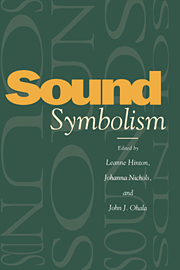Book contents
- Frontmatter
- Contents
- List of contributors
- 1 Introduction: Sound-symbolic processes
- PART I Native American languages north of Mexico
- PART II Native languages of Latin America
- PART III Asia
- PART IV Australia and Africa
- PART V Europe
- PART VI English
- PART VII The biological bases of sound symbolism
- 21 Some observations on the function of sound in clinical work
- 22 The frequency code underlies the sound-symbolic use of voice pitch
- 23 Sound symbolism and its role in non-human vertebrate communication
- Index
21 - Some observations on the function of sound in clinical work
Published online by Cambridge University Press: 04 August 2010
- Frontmatter
- Contents
- List of contributors
- 1 Introduction: Sound-symbolic processes
- PART I Native American languages north of Mexico
- PART II Native languages of Latin America
- PART III Asia
- PART IV Australia and Africa
- PART V Europe
- PART VI English
- PART VII The biological bases of sound symbolism
- 21 Some observations on the function of sound in clinical work
- 22 The frequency code underlies the sound-symbolic use of voice pitch
- 23 Sound symbolism and its role in non-human vertebrate communication
- Index
Summary
Introduction
People who request medical attention usually produce various sounds, including physiological noises, vocal expressions, and spoken language. Physiological noises are meaningful in that they may point directly to a malfunctioning organ. Vocal expressions indicate the emotions experienced by a patient. Speech communicates the patient's observations, thoughts, and beliefs about disease.
The study of so vast an array of sonic behaviors requires a number of different approaches, including acoustic methods (Ostwald 1963) and semiotic analysis (Ostwald 1973). The study of language has always been important for clinical research, particularly in psychiatry, which is the branch of medicine most closely connected to the exploration of psychological and social issues in human behavior (Kaplan 1974). In recent years, there has also been a considerable amount of psycholinguistic investigation of human soundmaking (Andreasen and Hurtig 1980). The present paper will (1) define what is meant by clinical work, (2) describe certain disease states that manifest themselves sonically, and (3) discuss some of the processes involved in communication about disease, specifically those concerning language and emotion.
What do we mean by “clinical work”?
Clinical work is conducted within a social network consisting of patients who seek relief from diseases, clinicians capable of diagnosing and treating them, and cultural expectation about the nature and course of these diseases. This work is action-oriented: clinicians must respond immediately to the needs of their subject – a living, suffering, or dying patient. Interactions and interventions predominate, not the contemplative analysis of phenomena, or the abstract pursuit of knowledge.
- Type
- Chapter
- Information
- Sound Symbolism , pp. 309 - 324Publisher: Cambridge University PressPrint publication year: 1995



